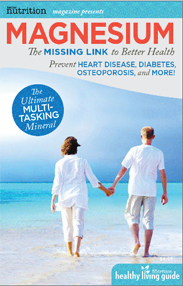Bad Diet and Lack of Exercise Contribute to Osteoporosis and Poor Bone Health
 In addition to the approximately eighteen nutrients essential for healthy bones, including magnesium, the other factors that are important …
In addition to the approximately eighteen nutrients essential for healthy bones, including magnesium, the other factors that are important …
… in the development of osteoporosis include diet, drugs, endocrine imbalance, allergies, vitamin D deficiency, and lack of exercise. A detailed review of the osteoporosis literature shows that chronically low intake of magnesium, vitamin D, boron, and vitamins K, B12, B6, and folic acid leads to osteoporosis. Similarly, chronically high intake of protein, sodium chloride, alcohol, and caffeine adversely affects bone health.1, 2.
The typical Western diet (high in protein, salt, and refined and processed foods) combined with little or no exercise or an inactive lifestyle contributes to the increasing incidence of osteoporosis.
If you drink coffee and/or wine, smoke cigarettes, eat junk food or any processed sugary foods and/or drink sodas, you are causing calcium and magnesium, and the other nutrients that have to deal with toxins, to be overworked or flushed out of your body. You are setting yourself up for a magnesium deficiency and an increased risk of developing osteoporosis.
A high-protein diet and excess sugar, alcohol, and coffee all rob the body of essential minerals. Prevention in the form of fruit and vegetables containing large amounts of calcium, magnesium, and potassium contributes to maintenance of bone mineral density.3
The foods that are high in calcium are usually abundant in magnesium as well, including nuts and seeds, sardines, bok choy (Chinese cabbage), and broccoli.
Add more vegetables, whole grains, legumes, nuts, and seeds to your diet, and be sure to include some of the following magnesium-rich foods but keep in mind that today’s soils are depleted of vital nutrients and minerals making our food depleted in these essentials.
Nutritional Magnesium in Food (mg) per 3 1/2 oz (100g) serving
Kelp 760
Wheat bran 490
Wheat germ 336
Almonds 270
Cashews 267
Molasses 258
Yeast, brewer’s 231
Buckwheat 229
Brazil nuts 225
Dulse 220
Filberts 184
Peanuts 175
Millet 162
Wheat grain 160
Pecan 142
English walnuts 131
Rye 115
Tofu 111
Coconut meat, dried 90
Brown rice 88
Soybeans, cooked 88
Figs, dried 71
Apricots 62
Dates 58
Collard greens 57
Shrimp 51
Corn, sweet 48
Avocado 45
Cheddar cheese 45
Parsley 41
Prunes, dried 40
Sunfower seeds 38
Barley 37
Beans, cooked 37
Dandelion greens 36
Garlic 36
Raisins 35
Green peas, fresh 35
Potato with skin 34
Crab 34
Banana 33
Sweet potato 31
Blackberry 30
Beets 25
Broccoli 24
Cauliflower 24
Carrot 23
Celery 22
Beef 21
Asparagus 20
Chicken 19
Green pepper 18
Winter squash 17
Cantaloupe 16
Eggplant 16
Tomato 14
Milk 13
Important Note:
Modern agricultural practices have depleted the nutrient content of our soils and our foods creating common health issues due to vital mineral deficiencies in our diet. Agricultural and nutritional experts say that our fruits and vegetables have lost between 15 to 75 percent of their nutrients over the last half century. Add vitamin and mineral supplements to your diet to make-up for the depleted content of our soils and food.
References:
1. Thomas AJ et al., Ca, Mg and P status of elderly inpatients: dietary intake, metabolic balance studies and biochemical status. Br. J. Nutr, vol. 62, pp. 211-219, 1989.
2. Bunker VW, Osteoporosis in the elderly. Br J Biomed Sci, vol. 51, no. 3, pp. 228-240, 1994.
3. Tucker KL et al., Potassium, magnesium, and fruit and vegetable intakes are associated with greater bone mineral density in elderly men and women. Am J Clin Nutr, vol. 69, no. 4, pp. 727-736, 1999.
Newsletter
![]()

Want valuable information regarding the health benefits of magnesium, latest studies, expert interviews,videos and health tips? Enter your name and email address and you can start receiving valuable health information right away.
Featured On:








